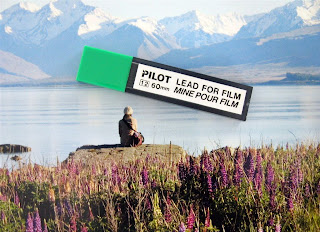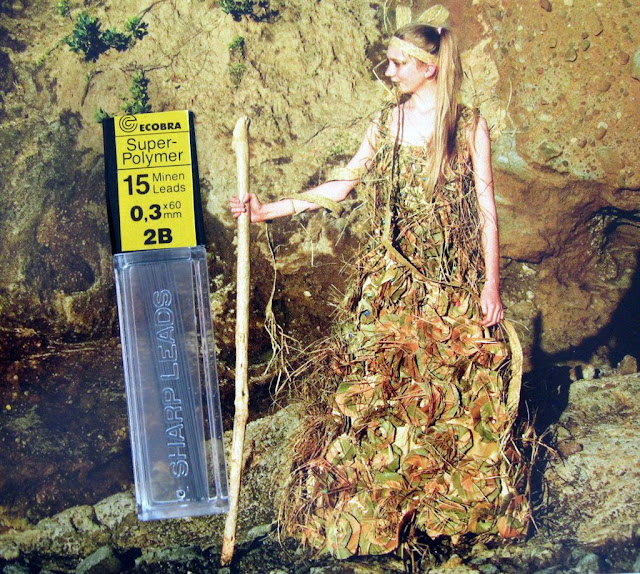Arne, our man up over in Hamburg, hometown of Rotring and Montblanc, has left a comment or two on this blog, and knowing that I like my leads, he recently sent me a couple of containers of uncommon leads.
First is a container of Pilot ‘Lead For Film’.
I’ve never done any film work so don’t mistake me for someone who really knows what they are talking about, but along with paper, polyester (aka mylar) film was a common draughting substrate. Clear film is dimensionally stable and tear resistant, allows multiple erasings and revisions, and of course allows you to make overlays and you can draw on both sides to enhance artistic effects. Compared to paper it also has better archival and copy-reproduction properties. You can use ordinary lead to draw on film, and many brands claim their leads are suitable for ‘paper and film’ but these special film leads are optimised for drawing on polyester film rather than on paper. I don’t imagine they are big sellers, but for example Pentel USA still offer them, with hardness grades soft, medium and hard, rather than the usual HB scale.
For a quick comparison, I did a bit of scribbling with the Pilot Lead For Film 0.7mm grade H and with Staedtler grade H ‘ordinary’ leads. The film leads really are significantly harder and lighter than Staedtler 'ordinary leads' grade H, so perhaps a film lead H (for Hard) is more like a 3H in ordinary leads.
Right then, moving on, second in the parcel from Hamburg were some 0.3mm leads that are new to me.
Ecobra is a German brand of compasses and other such drawing supplies. Now, the name Ecobra is an acronym and I don’t know how to pronounce it. For example is it 'short syllable – long syllable', evoking imagery of turbans, hypnotic flute music and venomous snakes, or is it 'two equal length syllables', producing mental pictures of environmentally friendly 100% organic cotton supportive undergarments. Either way, here’s Ecobra's current lead offering. Apparently they haven’t offered 2B 0.3mm for 10+ years, so these containers are old Hamburgian treasure hoard.
The Ecobra lead containers look like generic Japanese ‘Sharp Leads’ so I imagine these leads are probably re-labelled standard production from some Japanese lead manufacturer. Arne also most generously sent a 0.3mm pencil to help test drive these leads. Now, before I took them for a quick spin around the block, here’s what I expected to write, “As you might expect with such thin leads in grade 2B they write dark and they wear down quickly.” In reality though I didn’t find them that much different from my Pentel Super Hi-Polymer 0.3mm HB, although you should bear in mind that I am an inexperienced user of 0.3mm leads. Certainly they were darker, although at times it wasn’t as obvious as it appears below.
Strength wise they were a little weaker than Pentel HB, but again it was a rather limited difference. As for wear, yet again less of a difference than I expected so whilst I would say the Ecobra 2B wore down faster, there wasn’t that much in it.
Whilst conducting this test I encountered a rather unusual problem. The Rotring 600 would not feed new leads through from the lead storage magazine. I clicked and clicked, stuck more leads in, shook things around, clicked and clicked, all to no avail. I then decided on the (for me) radical course of disassembly, and immediately discovered the cause of the problem.
All the leads were stuck to the walls of the plastic lead refill magazine by static electricity. I haven’t ever had this problem before. I’m under the impression that the manufacturers put an anti-static additive in the plastic of the refill tubes to eliminate this problem. Maybe this batch of plastic tubing got under-dosed, or Hamburg static multiplies many-fold when transported down under? Well I walked around the house sticking the plastic tube on all the bits of metal I thought might be grounded and it did seem to help, the leads became less inclined to stick to the walls, and with a bit of effort and shaking I could get new ones to feed through into the mechanism. Anyone else ever encountered this sort of problem? Are the extra light 0.3mm sticks of lead more prone to this than heavier thicker sticks?
Tuesday, May 18, 2010
Subscribe to:
Post Comments (Atom)











20 comments:
Oh.....
I'm a bit interested of the static electricity problem........... I swear that I've never see or even hear that problem before. and also never think that static electricity will happen in the leads tube. Maybe it happened but I don't know [but I don't think it would]
so....... Thank you for information and I'll tell you if that problem happen to my pencils
It sounds like a possibility considering that graphite is actually a conductor of electricity. Maybe some thing about the transportation method wast he cause.
I should note that I've had lead shavings/pieces get attracted to my laptop's power connection (apple magsafe) because it uses a strong magnet to hold the power cord.
Interesting to hear of your graphite loving Apple.
Hello Dave, seeing those leads and your review took me back a few years to the ol' drawing board. At the time we used to use Pentel film leads on Melinex (coated Mylar) because it lays down a fairly even line as well as being a lot more smudge resistant. I never liked using Melinex, but it was convenient for copying then modifying similar site plans, or assembly drawings. I think that the leads may have a polymer component to the binder. They erased well from film and you could ink-over the layout lines pretty well.
For the amount of money they ask for a Rotring 600, I would've at least expected it to have been an all-metal pencil instead of cheapening it with that internal plastic lead refill magazine. It's somewhat diappointing.
I always wondered how you people down under walk with the feets pointing up... At least the leads "feel", that something is wrong there :-)
BTW: Germ had a pencil marked "For Film" some days ago -- so he has the pencil and you have the leads...
oops, I meant Germ had this pencil shown on his blog, of course...
Mylar drawing films had a matte face for drawing while the back side was polished smooth, mirror smooth and absolutely nothing would stick to it. The drawing side, however, was wonderful; with soft (B or 2B) "film" leads you could put down a line that was as black as India ink, and still could erase it if necessary.
Ah, the mechanical pencils of Pentel, Pilot, Faber Castell, Tombow,...in the 1980's were such beautiful pieces of engineering and craftsmanship. An age we'll never see again.
Prof pi
2nd - that is a good theory. The leads were obviously confused...so I should have held the pencil tip upwards and that way they would have fed a new lead into the mechaism.
Prof pi - thanks for your comment. I don't like disagreing with someone who has actually used mylar film, and my experience of film was limited to a brief lesson or two, but I did do a little research before wrting this post and found an architectural textbook that mentioned specifically about stippling on both sides of the film and how it gave artisitc effects that would enhance the drawing, etc. So perhaps there were specific films intended either for single or double sided use?
Tim - sorry, forgot to say Hello back. Good to hear from you. Yes, I imagine they are still a polymer lead, despite their differences.
I never heard of film leads before. Amazing what variety of leads and pencils were produced in the past (copy, non-copy, film, ...). How do the film leads perform on film? Maybe they will be a tick darker, because they are designed to stick better to film than to paper?
> Now, the name Ecobra is an acronym and I
> don’t know how to pronounce it.
I would pronounce it with stress on the second syllable (to have an association with the cobra snake, to which the logo seems to refer). Btw, there is an inconsistency in the acronym: the last "a" stands for Aktiengesellschaft (stock corp.), while the company today actually is a GmbH (Ltd.)...
Whoa! That's the biggest box of leads I've ever seen! Do you think they fit into that writing stick she's holding? Wonder what she writes, and where?
I hope she doesn't smoke. One spark and that dress of hers would look like Thomas More at work on the Protestants.
She probably uses those big leads to draw on the walls of her cave :-)
I get the dress now, it goes with the eco-bra she is no doubt wearing.
yes, smaller diameter leads are more prone to sticking to the plastic. It is due to the weight to surface area ratio.
Today, plastic film manufacturers use petrochemical raw materials such as PET (polyester film manufacturers) resin and PP (polypropylene) resin to manufacture these films.
That's right. I have Pentel For Film Set.
I had this sticking problem on my Orenz Nero 0.2mm to the extent that it became unusable..just couldn't for the life of me get any lead to drop to the base of the tube, damn static.
Hmmmm, that's interesting 21/2p.
Post a Comment